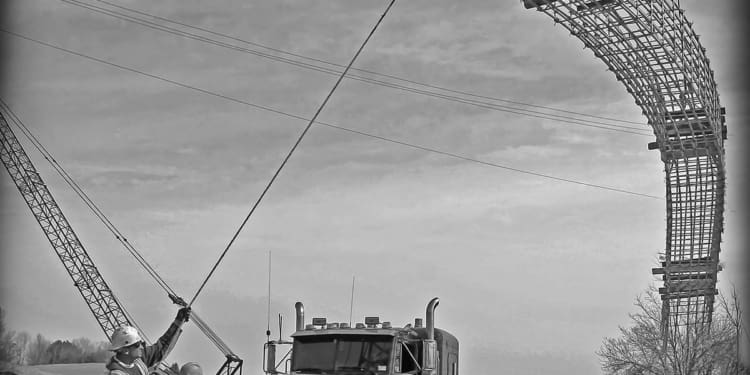This is the tale of two photographers.
One captured the unspeakable scars left by the Battle of Stalingrad in World War II; the other, untold stories of construction sites and their workers. Two vastly opposing concepts that come together in one art exhibit, “Frame Story: The Narrative Within,’” that allows viewers to make their own new story. “The contrast between my exhibit and Emma’s exhibit is, in itself, a moving experience … I would suggest looking at those survivors of the battle as grandparents that we all know and feel comfortable and familiar with,” said Roy W. Stevens, one of the photographers. “On the other side [is] the project I call ‘men of steel.’ We sort of have to build a familiarity with them. They are not people doing things that we have experience with so I think putting this together as co-exhibitors was quite perceptive … it works well.” Stevens has been photographing for 18 years, everything from landscapes to construction sites. What’s housed at the Arts Center Gallery at Saratoga Arts until Nov. 12 is a collection of black and white photos from the past four years that give a peek behind the buildings or bridges we pass every day. “Principally, it tells the story that we don’t as consumers or users of industrial or heavy construction think about; the people who put them together,” said Stevens. “We’ve crossed bridges often twice a day or huge overpasses or we are in large concrete buildings and we don’t ever contemplate how that came to be.” Through his work with a steel firm in Schenectady County, Stevens gained access to steel fabricating shop floors and construction sites usually off limits to the general public. “I took special attention to composition, to the geometry; the drama of people on high steel beams or with welding torches,” said Stevens. What he ended up with was a pictorial documentary that gave the anonymous a chance to speak.
“The engineers, the craftsmen, the laborers are crucial to the construction; to the design and placement of these structures,” said Stevens. “We don’t consciously avoid looking for these things; we’re just not permitted or allowed for all kinds of reasons.” Stevens said it was when he was roving the prohibited spaces (camera in tow) and taking in the unfamiliar atmosphere that he knew, without a doubt, this project was right. “I thought, ‘I have an opportunity to develop this and present it to folks in an artful way,’” said Stevens. Emma Dodge Hanson is the other photographer. Her project couldn’t be more different but is no less affecting. “I was asked to go on a photo shoot in Moscow and Germany to document the last survivors of the Battle of Stalingrad,” said Hanson, who accompanied Rutgers University professor Jochen Hellbeck. “We went into people’s homes. It was powerful.” Hanson doesn’t speak Russian or German, so armed with just a camera and her own intuition, her photos turned out vulnerable, raw and dramatic. “You really just have the visual to go on when they’re telling stories about things that are horrific,” said Hanson. “I was looking at the expressions on their face and not understanding their words.” Though Hellbeck shared the stories as they traveled from home to home, Hanson already had a deeper understanding of the emotions her subjects were relaying through their memories. “One of the images was of a beautiful older gentleman in his apartment with big cheekbones, listening to his wife talk about crossing the river at night when it was not possible for everyone to swim and I could tell from the expression on his face how horrible the stories were,” said Hanson. Another image shows a man, who before becoming the rabbit killer he is today, made a gruesome discovery on a road in Stalingrad. “He picked up a belt buckle attached to a man and realized the road had been paved with bodies, some women and children,” said Hanson. Hanson also snapped the portrait of a man still haunted by what he saw on the last day of battle when the Germans surrendered. “[He] told us about living in an abandoned factory with Russians on one floor and Germans on another floor. On the last day of the battle at about 4 in the morning, he saw eight of the generals get in their full dress and march into a room after polishing their boots and belt buckles and spiffed up their hats,” said Hanson. “All eight of them said ‘Long live Germany!’ and killed themselves in front of everybody.” The images displayed in the Arts Center are part of her non-profit work, which makes up one third of her business. “I think I’m morally obligated to always be doing something to give back,” said Hanson. The rest of her business is split evenly between weddings around the U.S. and authors, musicians and families. Documentary photography like the Stalingrad survivors, though, is something she looks forward to doing each year. “The truth in documentary photography … there’s nothing interesting about telling somebody what to do and capturing that,” said Hanson. “The most beautiful images are the real ones where you’re just a witness or a fly on the wall, you’re not the director.” Viewers will see Hanson’s images in the most natural state possible.
“They’re not under glass because I don’t want people to see a reflection of themselves and they’re printed big because I want people to be consumed by them,” said Hanson. An opening reception for “Frame Story: The Narrative Within” is Saturday, Oct. 8 from 6 to 8 p.m. A discussion with the artists will take place just prior to that at 5 p.m. The Arts Center Gallery is at 320 Broadway in Saratoga Springs.
The ‘Narrative Within’
Leave Comment



